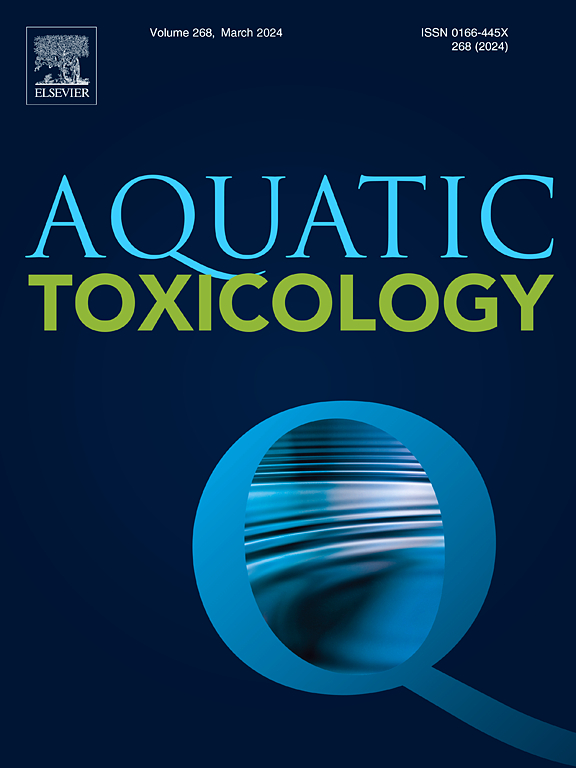An adverse outcome pathway approach linking retinoid signaling disruption to teratogenicity and population-level outcomes
IF 4.1
2区 环境科学与生态学
Q1 MARINE & FRESHWATER BIOLOGY
引用次数: 0
Abstract
Recent research efforts in endocrine disruption have focused on evaluating non-EATS (estrogen, androgen, thyroid, and steroidogenesis) pathways. Retinoid signaling disruption is noteworthy because of its teratogenic effects and environmental relevance. However, current environmental risk assessments are limited in their ability to evaluate impacts on individuals and populations. This study characterizes an Adverse Outcome Pathway (AOP) network linking retinoid signaling disruption to teratogenicity and survival in zebrafish. We identified Retinoic Acid Receptor (RAR) overactivation as the molecular initiating event leading to key events including craniofacial (CFM) and tail (TM) malformations, posterior swim bladder (SB) non-inflation, impaired swimming performance, and reduced feeding, ultimately resulting in decreased survival. Our study (1) determines critical sensitivity windows for CFM, posterior SB non-inflation, and TM, (2) provides quantitative measurements for CFM and TM, and (3) defines impacts on higher biological levels including food ingestion, swimming, and survival. Results show that all-trans retinoic acid (ATRA) induces strong teratogenic effects with sensitivity windows between 4 and 48 h post fertilization (hpf) for CFM, TM, and posterior SB non-inflation. TM is the most sensitive indicator, with EC50 of 0.2 - 0.26 µg/L across exposure windows 4–48, 4–72, 4–96, and 4–120 hpf. Besides inducing known malformations, ATRA impaired posterior SB inflation with EC50 of 1 - 1.21 µg/L across the same exposure windows. ATRA exposure (1 µg/L) resulted in 50 % food ingestion inhibition at 7 days post fertilization (dpf) and 10 % survival at 14 dpf. This study provides a regulatory-relevant framework linking developmental effects to population outcomes, highlighting ecological risks and needs for improved risk assessments.
将视黄醇信号干扰与致畸性和人群结果联系起来的不良结果途径方法。
近期有关内分泌干扰的研究重点是评估非 EATS(雌激素、雄激素、甲状腺和类固醇生成)途径。视黄醇信号干扰因其致畸效应和环境相关性而值得关注。然而,目前的环境风险评估在评估对个人和群体的影响方面能力有限。本研究描述了将视黄酸信号干扰与斑马鱼的致畸性和存活率联系起来的不良后果途径(AOP)网络。我们发现视黄酸受体(RAR)过度激活是导致颅面(CFM)和尾部(TM)畸形、后鳔(SB)不充气、游泳性能受损和摄食减少等关键事件的分子启动事件,最终导致存活率下降。我们的研究(1)确定了CFM、后鳔不充气和TM的临界敏感性窗口,(2)提供了CFM和TM的定量测量值,(3)确定了对摄食、游泳和存活等更高生物水平的影响。结果表明,全反式维甲酸(ATRA)会诱发强烈的致畸效应,其对CFM、TM和后SB不充气的敏感性窗口在受精后4到48小时(hpf)之间。TM是最敏感的指标,在4-48、4-72、4-96和4-120 hpf的暴露窗口中,EC50为0.2 - 0.26 µg/L。除了诱发已知的畸形外,ATRA 还会损害后 SB 膨涨,在相同的暴露窗口中,其 EC50 值为 1 - 1.21 µg/L。暴露于ATRA(1 µg/L)会导致受精后7天(dpf)的摄食抑制率为50%,14 dpf的存活率为10%。这项研究提供了一个与监管相关的框架,将发育影响与种群结果联系起来,突出了生态风险和改进风险评估的需要。
本文章由计算机程序翻译,如有差异,请以英文原文为准。
求助全文
约1分钟内获得全文
求助全文
来源期刊

Aquatic Toxicology
环境科学-毒理学
CiteScore
7.10
自引率
4.40%
发文量
250
审稿时长
56 days
期刊介绍:
Aquatic Toxicology publishes significant contributions that increase the understanding of the impact of harmful substances (including natural and synthetic chemicals) on aquatic organisms and ecosystems.
Aquatic Toxicology considers both laboratory and field studies with a focus on marine/ freshwater environments. We strive to attract high quality original scientific papers, critical reviews and expert opinion papers in the following areas: Effects of harmful substances on molecular, cellular, sub-organismal, organismal, population, community, and ecosystem level; Toxic Mechanisms; Genetic disturbances, transgenerational effects, behavioral and adaptive responses; Impacts of harmful substances on structure, function of and services provided by aquatic ecosystems; Mixture toxicity assessment; Statistical approaches to predict exposure to and hazards of contaminants
The journal also considers manuscripts in other areas, such as the development of innovative concepts, approaches, and methodologies, which promote the wider application of toxicological datasets to the protection of aquatic environments and inform ecological risk assessments and decision making by relevant authorities.
 求助内容:
求助内容: 应助结果提醒方式:
应助结果提醒方式:


